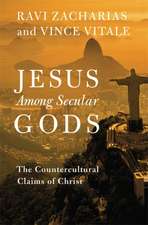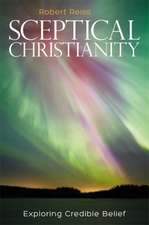Christological Anthropology in Historical Perspective: Ancient and Contemporary Approaches to Theological Anthropology
Autor Marc Cortezen Limba Engleză Paperback – feb 2016
Many theologians begin their discussion of the human person by claiming that in some way Jesus Christ reveals what it means to be “truly human,” but this often has little impact in the material presentation of their anthropology. Although modern theologians often fail to reflect robustly on the relationship between Christology and anthropology, this was not the case throughout church history. In this book, examine seven key theologians and discover their important contributions to theological anthropology.
Preț: 158.13 lei
Nou
Puncte Express: 237
Preț estimativ în valută:
30.26€ • 31.26$ • 25.17£
30.26€ • 31.26$ • 25.17£
Carte disponibilă
Livrare economică 26 februarie-12 martie
Preluare comenzi: 021 569.72.76
Specificații
ISBN-13: 9780310516415
ISBN-10: 0310516412
Pagini: 272
Dimensiuni: 152 x 229 x 17 mm
Greutate: 0.36 kg
Editura: Zondervan Academic
Colecția Zondervan Academic
Locul publicării:Grand Rapids, United States
ISBN-10: 0310516412
Pagini: 272
Dimensiuni: 152 x 229 x 17 mm
Greutate: 0.36 kg
Editura: Zondervan Academic
Colecția Zondervan Academic
Locul publicării:Grand Rapids, United States
Descriere
What does it mean to be “truly human?” In Christological Anthropology in Historical Perspective, Marc Cortez looks at the ways several key theologians—Gregory of Nyssa, Julian of Norwich, Martin Luther, Friedrich Schleiermacher, Karl Barth, John Zizioulas, and James Cone—have used Christology to inform their understanding of the human person. Based on this historical study, he concludes with a constructive proposal for how Christology and anthropology should work together to inform our view of what it means to be human.
Many theologians begin their discussion of the human person by claiming that in some way Jesus Christ reveals what it means to be “truly human,” but this often has little impact in the material presentation of their anthropology. Although modern theologians often fail to reflect robustly on the relationship between Christology and anthropology, this was not the case throughout church history. In this book, examine seven key theologians and discover their important contributions to theological anthropology.
Many theologians begin their discussion of the human person by claiming that in some way Jesus Christ reveals what it means to be “truly human,” but this often has little impact in the material presentation of their anthropology. Although modern theologians often fail to reflect robustly on the relationship between Christology and anthropology, this was not the case throughout church history. In this book, examine seven key theologians and discover their important contributions to theological anthropology.
Cuprins
Part One: An Empty Cipher1.The Glory of Christ, the Image of God, and the Christological Orientation of Theological AnthropologyPart Two: Centered on Christ through the Centuries2.What is a 'Will'?: Maximus' Cosmological Christology and Human Volitionality3.Prototype, Archetype, and Gender-type: Gregory of Nyssa and the Christological (De)gendering of the Human Person 4.Cross-Centered Vocation: The Theology of the Cross in Luther's Theological Anthropology5.Consciousness of God, Awareness of Self: Schleiermacher's Reconstruction of the imitatio Christi6.Summoned into Being: Body, Soul, and Eternal Election in Barth's Theology 7.Person, Persons, and Personhood: Zizioulas and the Ecclesial Nature of Humanity8.The Black Christ: James Cone and the Race-ing of the Human PersonPart Three: Tentative Steps Forward9.Reforming Our Anthropological Vision: Some Concluding Thoughts on the Shape of a Christ-Centered Theological Anthropology












